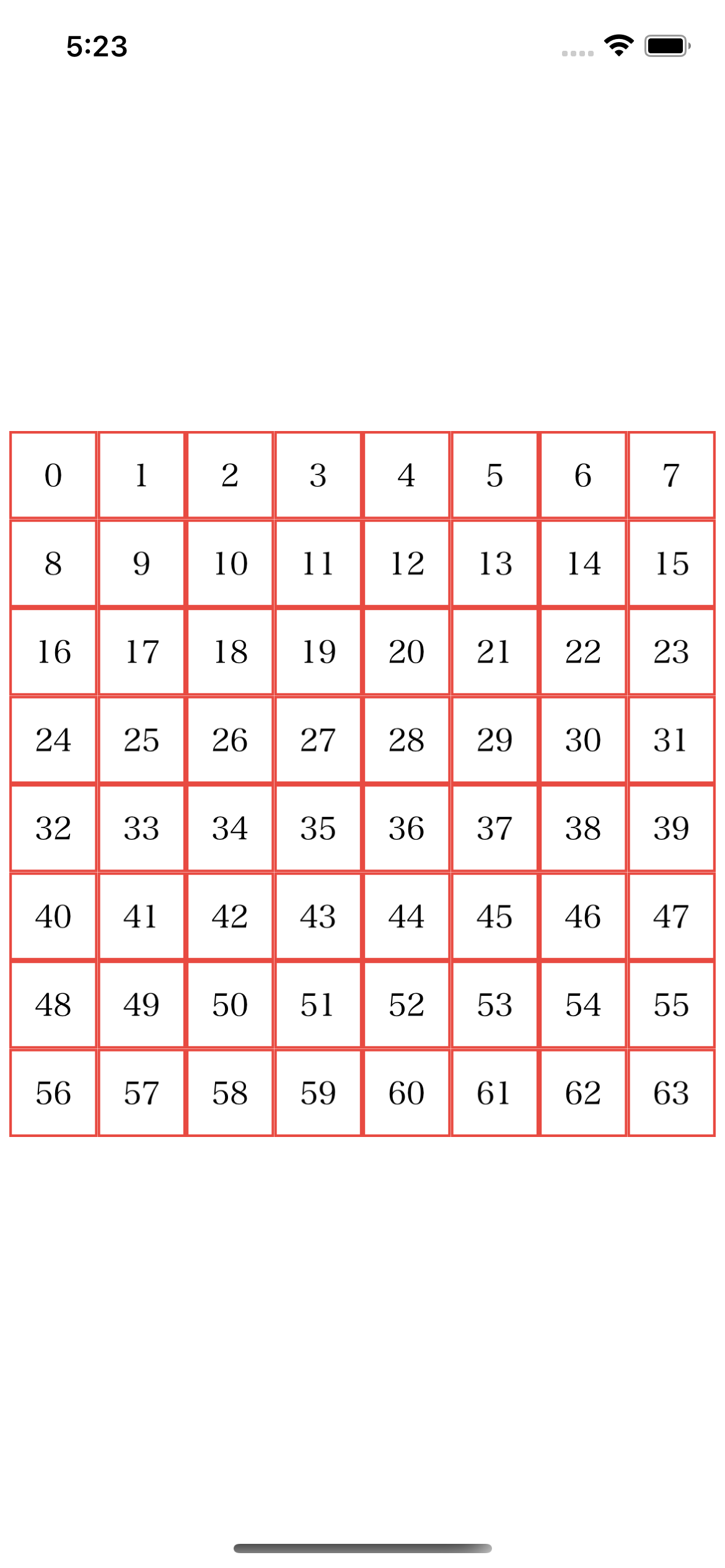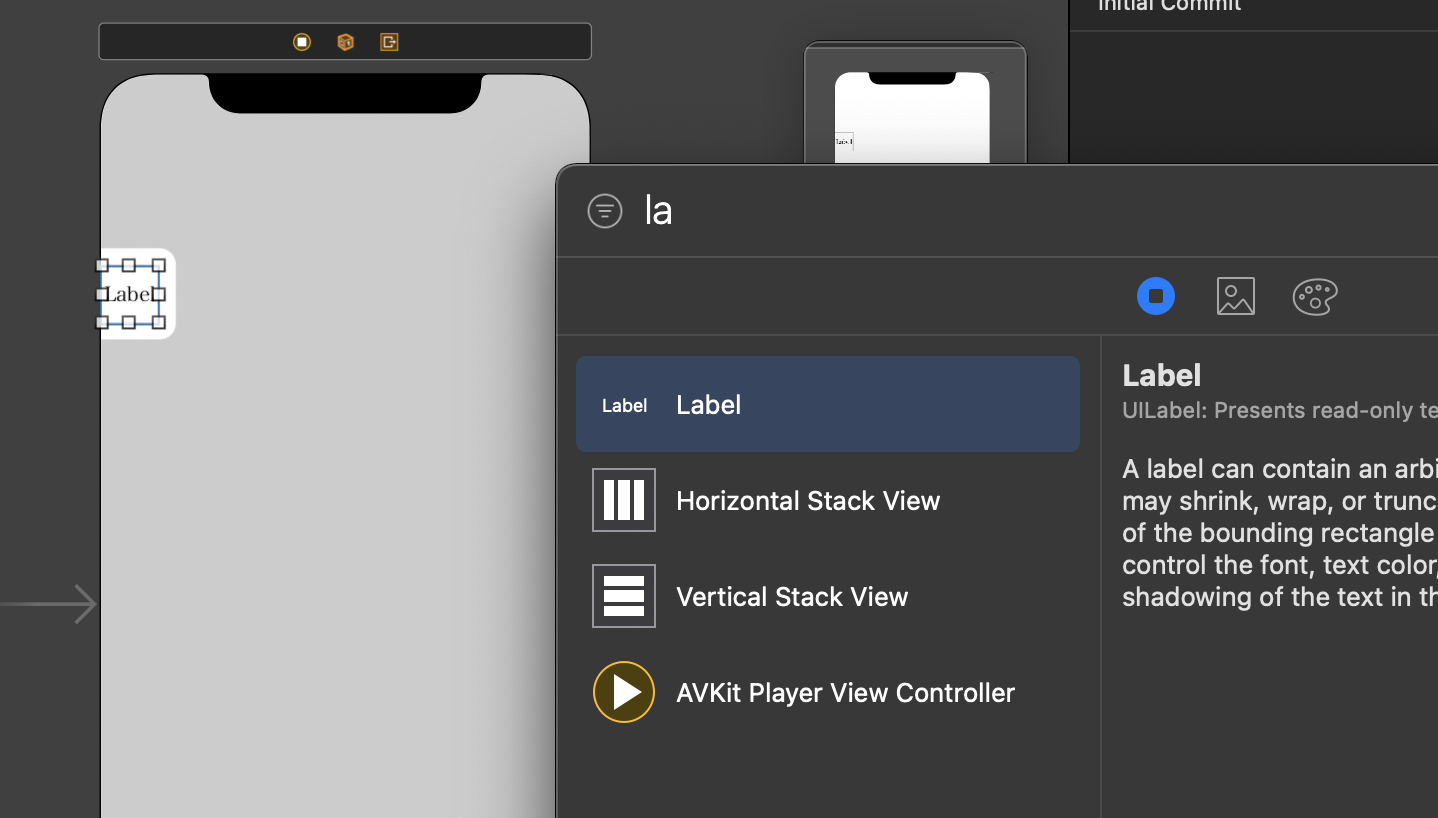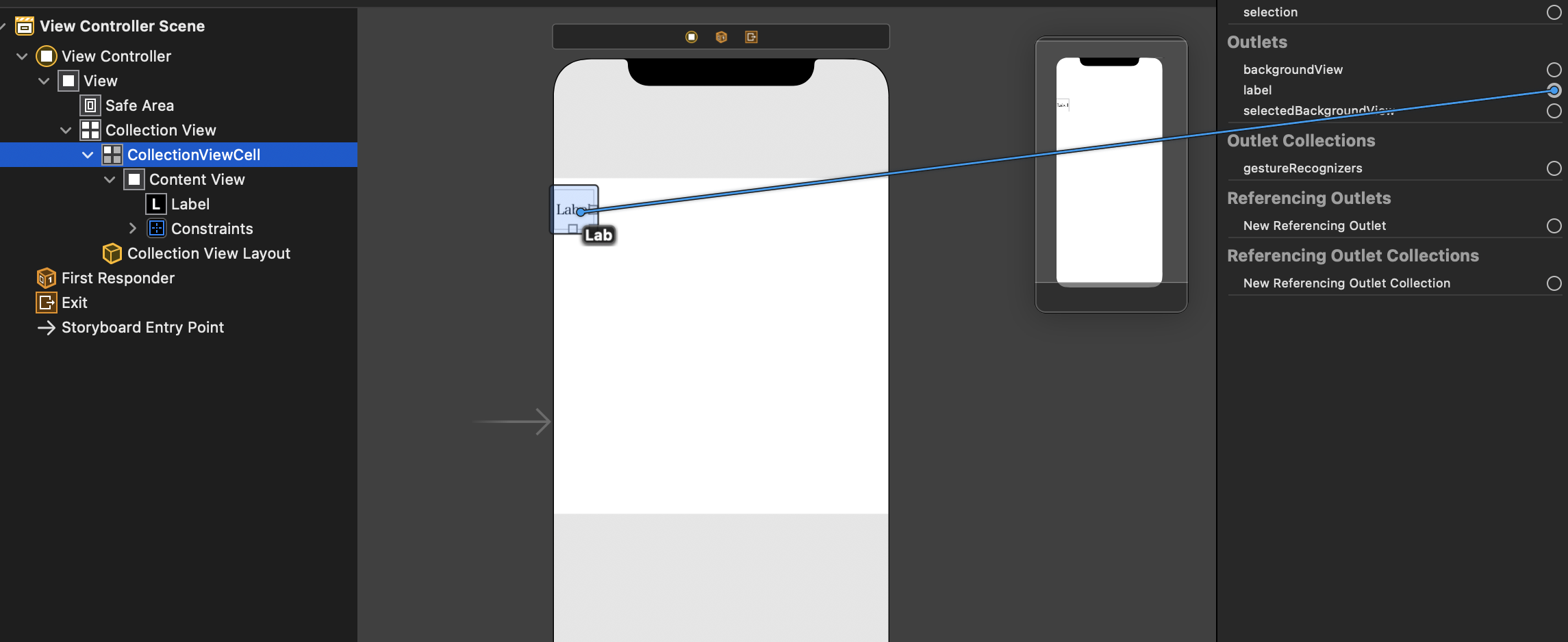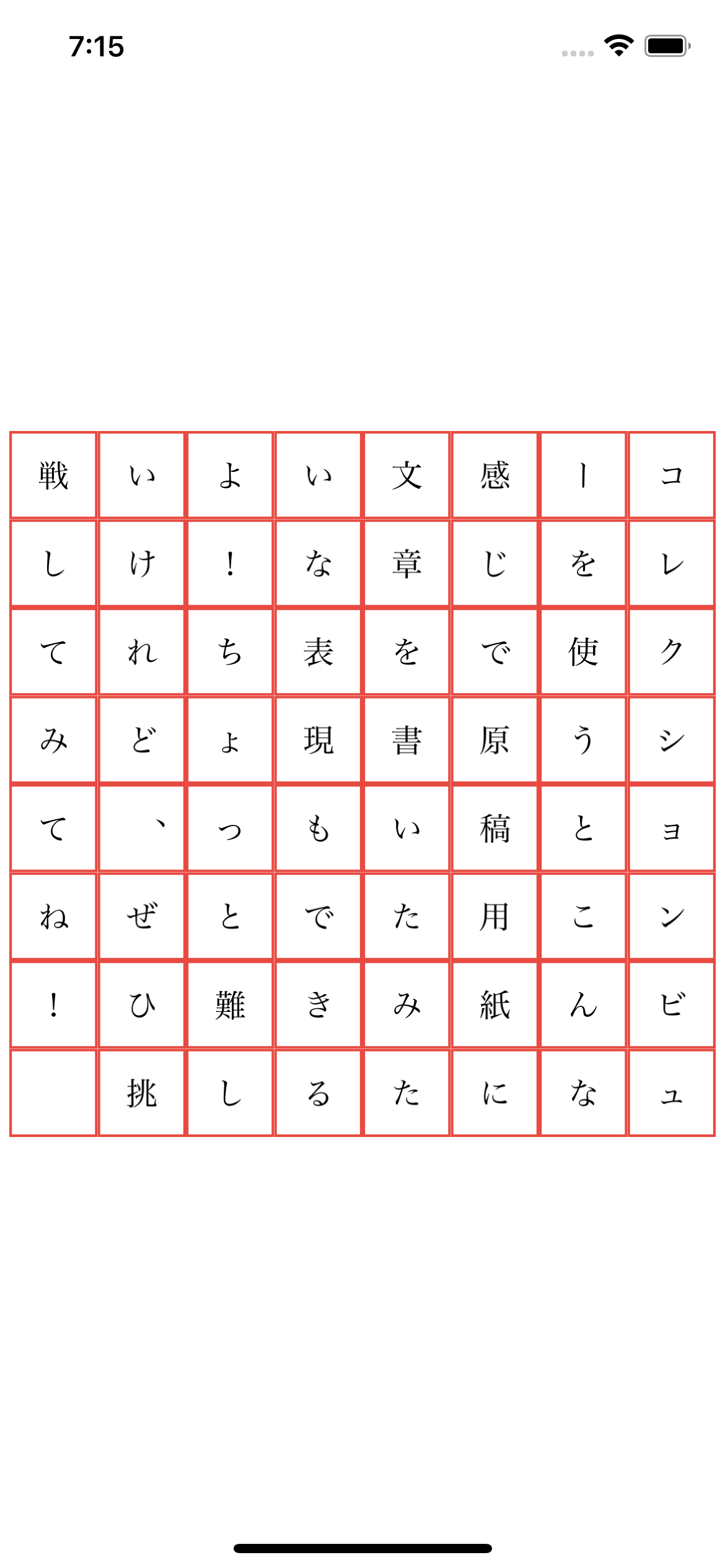CollectionViewを活用すると、複数のビューをまとめて管理することができます。特に、同じような見た目のビューをいくつも表示させたり、オセロ盤のようなマス目の表現にCollectionViewは向いています。
今回は以下のようなCollectionViewを作成してみます。
(環境:Xcode12.4 Swift5.3)

手順
CollectionView作成の手順は次のようになります。
- StoryBoard(ViewController)にUICollectionViewを配置
- CollectionViewCellの中にUIlabelを配置 & 関連付け
- ViewController.swiftファイルに変数を用意 & 関連付け
- ViewControllerにプロトコルを追加 (UICollectionViewDataSource, UICollectionViewDelegate)
- DataSourceとDelegateをViewController(Self)に指定
- メソッドを追加
- UICollectionViewLayoutクラスを継承したCollectionViewLayoutクラスを作成 & Layoutに指定
- UICollectionViewCellクラスを継承したCollectionViewCellクラスを作成 & Custom Classに指定
- 各セルに表示させる内容(text)をメソッドに記述
1. StoryBoard(ViewController)にUICollectionViewを配置
StoryBoardのUIViewControllerにUICollectionViewを配置しましょう。今回配置するUIViewControllerには ViewControllerクラスが設定されているとして説明していきます。ちなみに、CollectionViewの位置はAutoLayoutで設定するとうまく表示されないため、後ほどコードから設定していきます。

2. CollectionViewCellの中にUIlabelを配置 & 関連付け
CollectionViewを配置すると、その中に自動でCollectionViewCellも1つだけ配置されます。そのCellの中にLabelを配置していきます。ここではAutoLayoutが利用できるので、Cellの枠との幅を0に設定しておきます。

続いてCollectionViewCellのコネクションインスペクタを開いて、Outletsのlabelと先ほど配置したLabelとを関連付けします。これでCollectionViewCellのインスタンスから.labelとアクセスできるようになります。

3. ViewController.swiftファイルに変数を用意 & 関連付け
UIViewControllerのインスタンスを作成します。加えてStoryBoard上のUIViewControllerと関連付けしておきましょう。
@IBOutlet var collectionView: UICollectionView!
4. ViewControllerにプロトコルを追加
ViewControllerに以下のプロトコルを追加します。
- UICollectionViewDataSource
- UICollectionViewDelegate
class ViewController: UIViewController, UICollectionViewDataSource, UICollectionViewDelegate {
/*処理*/
}
5. DataSourceとDelegateをViewController(Self)に指定
ViewControllerのviewDidLoadメソッドの中で以下の記述を追加します。ついでにCollectionViewの配置場所の指定もしておきましょう。ここでは左右に少し余白を設け、画面中央に配置するようにしています。
override func viewDidLoad() {
super.viewDidLoad()
self.collectionView.bounds.size.width = self.view.bounds.size.width-10
self.collectionView.bounds.size.height = self.view.bounds.size.width-10
self.collectionView.center = self.view.center
collectionView.dataSource = self
collectionView.delegate = self
}
6. メソッドを追加
CollectionViewの処理に関わる以下のメソッドを追加します。
func numberOfSections(in collectionView: UICollectionView) -> Int {
//これは同じ設定のCollectionViewの数(Section数)を指定するメソッド。
//今回は1を返しておきましょう
return 1
}
//UICollectionViewDataSourceを読み込んだ時点で赤い警告が表示されるのでfixボタンをクリックすると自動で挿入される
func collectionView(_ collectionView: UICollectionView, numberOfItemsInSection section: Int) -> Int {
//これはcollectionViewの各セクションについてアイテム数(Cellの数)を指定するメソッド
//今回は64を返しておきましょう
return 64
}
//UICollectionViewDataSourceを読み込んだ時点で赤い警告が表示されるのでfixボタンをクリックすると自動で挿入される
func collectionView(_ collectionView: UICollectionView, cellForItemAt indexPath: IndexPath) -> UICollectionViewCell {
//これはcollectionView内の個々のcellについての処理をおこなうメソッド
//あとで処理を記述します
}
func collectionView(_ collectionView: UICollectionView, didSelectItemAt indexPath: IndexPath) {
//これはcell選択(クリック)時に呼ばれるメソッド
}
7. UICollectionViewLayoutクラスを継承したCollectionViewLayoutクラスを作成 & Layoutに指定
続いて、個々のCellのサイズや配置場所を設定するクラスを作成していきます。
次のコードでは、64個のCellを左上から右下へと順に配置しています。
import UIKit
class CollectionViewLayout: UICollectionViewLayout{
//行数
let columns = 8
//レイアウト
private var layoutData = [UICollectionViewLayoutAttributes]()
//レイアウトの準備
override func prepare() {
super.prepare()
self.layoutData.removeAll()
let allWidth = collectionView!.bounds.width
let columnWidth = allWidth / CGFloat(self.columns)
let columnHeight = columnWidth
var x:CGFloat = 0
var y:CGFloat = 0
for count in 0 ... collectionView!.numberOfItems(inSection: 0){
let indexPath = NSIndexPath(item: count, section: 0)
//レイアウトの配列に位置とサイズを登録する。
let frame = CGRect(x: x, y: y, width: columnWidth, height: columnHeight)
let attributes = UICollectionViewLayoutAttributes(forCellWith: indexPath as IndexPath)
attributes.frame = frame
layoutData.append(attributes)
//これはindexPath[1]が左上が0,右下が63となるように配置している
if ((count + 1) % columns != 0){
x += columnWidth
}else{
x = 0
y += columnHeight
}
}
}
//レイアウトを返す
override func layoutAttributesForElements(in rect: CGRect) -> [UICollectionViewLayoutAttributes]? {
return layoutData
}
}
CollectionViewLayoutクラスが作成できたら、StoryboardにてCollectionViewのLayoutに指定します。

8. UICollectionViewCellクラスを継承したCollectionViewCellクラスを作成 & Custom Classに指定
全てのCellにわたるレイアウトを設定するクラスを作成します。
次のコードではセルの枠線の太さと色を設定しています
import UIKit
class CollectionViewCell: UICollectionViewCell {
@IBOutlet var label: UILabel!
required init?(coder aDecoder: NSCoder) {
super.init(coder: aDecoder)
//cellの枠の太さ
self.layer.borderWidth = 1.4
//cellの枠の色
self.layer.borderColor = #colorLiteral(red: 0.9086276889, green: 0.2920762599, blue: 0.2549881935, alpha: 1)
}
色をコードで代入する場合には、以下のように予測変換を用いてColor Literalと入力することで直感的に色を指定できます。


またStoryboardにてCollectionViewCellのCustom Classに今作成したクラスを指定します。

9. 各セルに表示させる内容(text)をメソッドに記述
コードから各セルにアクセスできるよう、StoryboardにてCollectionViewCellのCollectionReusableViewのIdentifierにCollectionViewCellと設定しておきます。(先ほど作成したクラス名と同じなのはたまたまです)
続いてViewControllerのcollectionView(_ collectionView: UICollectionView, cellForItemAt indexPath: IndexPath) -> UICollectionViewCellメソッドに処理を追記していきます。ここでは、各セルの番号(numberOfItems)を表示するようにしています。引数として受け取るindexPathは2次元配列で、indexPath[0]にSection、indexPath[1]にSection内のCell番号(collectionView!.numberOfItems(inSection: 0))が格納されています。
func collectionView(_ collectionView: UICollectionView, cellForItemAt indexPath: IndexPath) -> UICollectionViewCell {
let cell = collectionView.dequeueReusableCell(withReuseIdentifier: "CollectionViewCell", for: indexPath) as! CollectionViewCell
cell.label.text = String(indexPath[1])
return cell
}
実行結果
実行結果は冒頭に示したように次のようになります。

応用
CollectionViewLayoutと、ViewController内の各セルの処理をするメソッドの記述を変更すると、例えば次のような表現もできるようになります。

参考
この記事は以下の情報を参考にして執筆しました。
- [CollectionViewの基礎]
(https://qiita.com/azuma317/items/bf1a687f912159297cb1) - [螺旋のCollectionViewを作ってみる]
(https://qiita.com/Sho-heikun/items/4b9c85a04957c5b66e7d)